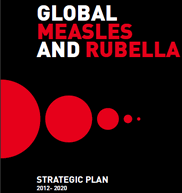Measles, Rubella & Congenital Rubella Syndrome (CRS) Elimination
As a founding member of the Measles and Rubella Initiative (M & RI), launched in 2001, CDC provides both scientific and technical support to partners and countries in other parts of the world to reduce measles and rubella deaths. CDC played a key role, in partnership with the Pan American Health Organization (PAHO), to develop a regional measles elimination strategy in 1996 that led to the elimination of this disease in the Americas in 2002 and the eventual declaration of measles elimination in 2016. CDC:
- Helps plan at a macro-and micro-level, implement, monitor, and evaluate measles and rubella vaccination campaigns in targeted areas to eliminate measles, rubella and CRS.
- Conducts operational research to provide evidence for recommendations that strengthen and guide measles- and rubella-control activities at the local, regional, and global levels.
- Helps evaluate the burden of rubella and CRS in countries to provide evidence for the introduction of rubella-containing vaccines.
- Provides technical assistance to conduct measles and rubella outbreak investigations, surveillance reviews, and routine vaccination program evaluations.
- Helps create and/or strengthen case-based measles, rubella, and CRS surveillance systems that allow countries to detect, monitor, and quickly respond to the presence of measles, rubella, and CRS.
- Serves as the global reference laboratory for measles and rubella.
- Provides resources for national reference laboratories.
- Provides technical assistance to global public health laboratories for the collection and shipment of clinical samples for measles testing using real-time polymerase chain reaction (RT-PCR).
2012–2020 Global Measles and Rubella Strategic Plan
 The 2012 to 2020 Global Measles & Rubella Strategic Plan [PDF - 1.28MB] describes five core components of a comprehensive measles and rubella elimination strategy:
The 2012 to 2020 Global Measles & Rubella Strategic Plan [PDF - 1.28MB] describes five core components of a comprehensive measles and rubella elimination strategy:
- Achieve and maintain high levels of population immunity by providing high vaccination coverage with two doses of measles and rubella containing vaccines.
- Monitor diseases using effective surveillance and evaluate programmatic efforts to ensure progress.
- Develop and maintain outbreak preparedness, respond rapidly to outbreaks, and manage cases.
- Communicate and engage to build public confidence and demand for immunization.
- Perform the research and development needed to support cost-effective operations and improve vaccination and diagnostic tools.
Regional Measles & Rubella Elimination Goals

WHO world map of regional goals for the elimination of measles and either the elimination or control of rubella
| WHO Region | Target Date for Measles Elimination | Target Date for Rubella Elimination or Control |
|---|---|---|
| African Region | 2020 | |
| Region of the Americas | 2000 | 2010 |
| South-East Asia Region | 2020 | 2020 |
| European Region | 2015 | 2015 |
| Eastern Mediterranean Region | 2015 | |
| Western Pacific Region | 2015 | 2015 |
Resources:
- Rubella and Congenital Rubella Syndrome Control and Elimination — Global Progress, 2000–2012
- Nationwide Rubella Epidemic – Japan, 2013
- Developing rubella vaccination policy in Nepal - results from rubella surveillance and seroprevalence and congenital rubella syndrome studies
- Global Control and Regional Elimination of Measles, 2000–2011
- Progress Toward Measles Elimination — Western Pacific Region, 2009–2012
- Progress Toward Regional Measles Elimination — Worldwide, 2000–2013
- Page last reviewed: December 9, 2014
- Page last updated: April 1, 2015
- Content source:
Global Health
Notice: Linking to a non-federal site does not constitute an endorsement by HHS, CDC or any of its employees of the sponsors or the information and products presented on the site.


 ShareCompartir
ShareCompartir